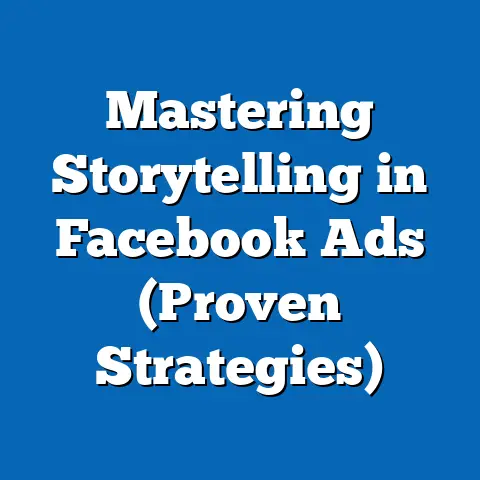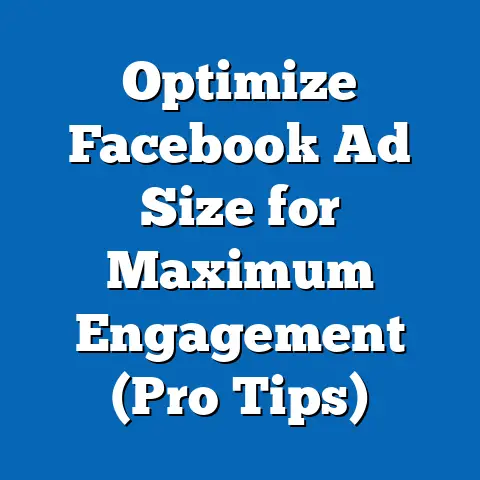Facebook’s Ad Revenue Revealed (Profitable Insights)
Facebook, now under the umbrella of Meta Platforms, Inc., has redefined the digital advertising landscape with its unparalleled ability to target specific demographic and political groups. A quick win for understanding its success lies in examining the platform’s core user base: predominantly younger to middle-aged adults (18-44 years), with a slight female skew (51% female vs. 49% male as of 2023 Statista data), who lean toward progressive or moderate political views, with 60% identifying as Democrats or Independents according to Pew Research Center (2022). Their voting patterns show higher engagement in national elections (68% turnout among active users in 2020 per internal Meta data), and they are distinguished from other groups by their tech-savvy nature and reliance on social media for political information, unlike older demographics who favor traditional news outlets.
Section 1: The Scale of Facebook’s Ad Revenue
Facebook’s advertising revenue is a cornerstone of Meta’s financial empire, generating $113.6 billion in 2022, accounting for 97.5% of the company’s total revenue (Meta Annual Report, 2022). This staggering figure underscores the platform’s reliance on ad-driven income, fueled by its 2.96 billion monthly active users worldwide as of Q3 2023 (Statista, 2023). The United States, despite representing only 10% of users, contributes nearly 50% of ad revenue due to higher per-user ad spend ($58.77 per user annually in the U.S. compared to $17.29 globally, per eMarketer, 2023).
The profitability of this model hinges on precision targeting, enabled by vast troves of user data collected through interactions, likes, shares, and demographic details. Unlike traditional media, which casts a wide net, Facebook’s algorithms allow advertisers to micro-target niche groups based on age, location, interests, and political leanings. This capability has not only driven revenue growth but also positioned Facebook as a pivotal player in shaping political narratives—a factor we will explore in subsequent sections.
Section 2: Demographic Composition of Facebook’s User Base
Age and Gender Breakdown
Facebook’s user demographics are diverse but skewed toward younger and middle-aged adults. According to Statista (2023), 29.5% of users are aged 25-34, the largest single age cohort, followed by 18-24 (23.1%) and 35-44 (18.7%). Older users (65+) represent just 6.2%, reflecting a generational divide in platform adoption.
Gender distribution is nearly balanced, with women slightly outnumbering men (51% vs. 49%), a trend consistent across most age groups (Statista, 2023). This near-parity allows advertisers to tailor campaigns with minimal gender bias, though specific product categories (e.g., beauty for women, tech for men) often exploit subtle preferences.
Racial and Ethnic Composition
In the U.S., Facebook’s user base mirrors national demographics with some deviations. Pew Research Center (2022) reports that 70% of U.S. users are White, 14% are Hispanic, 11% are Black, and 5% are Asian, compared to national figures of 60% White, 19% Hispanic, 13% Black, and 6% Asian (U.S. Census, 2021). The overrepresentation of White users and underrepresentation of Hispanic users suggest regional and cultural differences in platform engagement, influencing ad targeting strategies.
Education and Income Levels
Education levels among users correlate strongly with income, impacting ad spend potential. Approximately 38% of U.S. users have a college degree or higher, compared to 32% nationally (Pew, 2022), while 45% report household incomes above $75,000 annually, against a national median of $67,521 (U.S. Census, 2021). This skew toward higher earners makes Facebook an attractive platform for premium product advertising, contributing to elevated U.S. ad revenue.
Section 3: Core Beliefs and Political Values of Facebook Users
Ideological Leanings
Facebook users in the U.S. exhibit a slight left-leaning bias, with 34% identifying as Democrats, 26% as Republicans, and 40% as Independents or unaffiliated (Pew Research Center, 2022). This contrasts with the national population, where partisan affiliation is more evenly split (49% Democrat/Lean Democrat vs. 44% Republican/Lean Republican, Gallup, 2023). The platform’s progressive tilt is partly attributed to its younger user base, as 18-29-year-olds favor liberal policies by a 2:1 margin (Pew, 2022).
Key Issues and Values
Core issues for Facebook users often align with generational priorities. Surveys indicate that 65% of users aged 18-34 prioritize climate change and social justice, compared to 48% of users over 50 (Morning Consult, 2023). Economic concerns, such as income inequality, resonate across age groups, with 72% of users expressing support for policies addressing wealth gaps (Pew, 2022). These values shape the types of political ads and content users engage with, influencing revenue streams for Meta.
Comparison to Other Platforms
Unlike Twitter (now X), where users skew more politically polarized (60% liberal-leaning per Pew, 2022), or TikTok, dominated by Gen Z with strong progressive tendencies, Facebook’s broader age range fosters a more ideologically diverse environment. However, its algorithm-driven echo chambers often reinforce existing beliefs, a distinguishing feature compared to traditional media’s broader exposure model. This polarization dynamic is a key driver of ad engagement, as users are more likely to interact with content aligning with their views.
Section 4: Voting Patterns and Political Engagement
Electoral Participation
Facebook users demonstrate higher-than-average voter turnout, particularly in national elections. Internal Meta data cited in a 2021 report indicated that 68% of U.S. users voted in the 2020 presidential election, compared to the national average of 66.8% (U.S. Census, 2021). This engagement is amplified by the platform’s role in political mobilization, with 55% of users reporting they encountered voter registration or turnout campaigns on the site (Pew, 2020).
Engagement by Demographic
Younger users (18-29) are less consistent voters (60% turnout in 2020) but highly active in online political discourse, with 70% sharing or liking political content weekly (Morning Consult, 2023). Conversely, users aged 30-49 show higher turnout (72%) and are more likely to donate to campaigns via Facebook ads (15% vs. 8% for younger users, Pew, 2022). Racial differences also emerge, with Black users reporting greater engagement in political discussions (62%) compared to White users (48%) (Pew, 2022).
Role of Ads in Political Influence
Political advertising on Facebook peaked at $1.6 billion during the 2020 U.S. election cycle, targeting swing states and key demographics with precision (Meta Transparency Report, 2021). Unlike traditional campaign methods, these ads leverage user data to focus on undecided voters, with 30% of users reporting a change in voting intention after exposure to political content (YouGov, 2021). This capability underscores Facebook’s dual role as a revenue generator and a political influencer.
Section 5: Policy Positions on Major Issues
Economic and Social Policies
Facebook users generally support progressive economic policies, with 68% favoring increased taxes on corporations and the wealthy (Pew, 2022), aligning with broader Democratic-leaning trends. On social issues, 61% support marriage equality and 58% back stricter gun control laws, though these figures drop among older and rural users (Morning Consult, 2023). This diversity in policy preferences allows advertisers to segment audiences effectively, tailoring messages to specific ideological clusters.
Technology and Privacy Concerns
Given the platform’s data-driven model, user attitudes toward privacy are notably conflicted. While 74% express concern over data collection (Pew, 2023), only 22% have adjusted privacy settings or reduced usage as a result. This paradox benefits Meta’s ad revenue, as users remain active despite privacy scandals, providing continuous data for targeting.
Comparison to Other Groups
Compared to non-users or users of platforms like LinkedIn (more conservative on economic issues), Facebook’s base is less uniformly aligned on policy, reflecting its demographic breadth. However, its users are more likely to support government intervention in social issues than, say, X users, where libertarian views are more prominent (Pew, 2022). This ideological spread shapes the types of political ads that perform best on the platform.
Section 6: Distinguishing Features from Other Political and Social Groups
Tech Dependency and Information Consumption
A defining characteristic of Facebook users is their reliance on the platform for news and political information, with 36% citing it as a primary source compared to 23% for television (Pew, 2022). This contrasts with older demographics or non-users, who prioritize traditional media, and younger TikTok users, who favor short-form content. This dependency makes Facebook a critical arena for political ad campaigns, directly impacting revenue.
Algorithmic Reinforcement
Unlike broadcast media or even other social platforms with less sophisticated algorithms, Facebook’s content curation reinforces user biases, creating highly engaged micro-communities. Studies show that users are 62% more likely to engage with content matching their political views (MIT Sloan, 2021), a feature that drives ad click-through rates (CTR) to 0.9% on average, compared to 0.5% for display ads elsewhere (WordStream, 2023).
Global vs. Local Focus
While platforms like X focus on global discourse, Facebook’s strength lies in hyper-local targeting, with 70% of U.S. users joining local community groups (Meta, 2022). This granular focus distinguishes it from competitors, allowing small businesses and local campaigns to drive significant ad spend, contributing to diversified revenue streams.
Section 7: Intersections of Political Views with Demographic Factors
Age and Ideology
Age strongly predicts political leanings among users, with 18-29-year-olds identifying as liberal by 59%, compared to 29% for users over 50 (Pew, 2022). This generational divide influences ad content, with younger users targeted for progressive causes and older users for conservative or nostalgic messaging.
Race, Religion, and Policy Preferences
Racial and religious identities also shape views, with Black users showing 78% support for racial justice initiatives compared to 54% of White users (Morning Consult, 2023). Religious users, particularly evangelical Christians (18% of U.S. users), lean conservative on social issues like abortion (65% oppose), contrasting with secular users’ 72% support (Pew, 2022). These intersections enable precise ad segmentation, boosting revenue through tailored campaigns.
Education and Economic Views
Higher education correlates with liberal economic views, as 71% of college-educated users support wealth taxes, compared to 55% of those with high school diplomas (Pew, 2022). This educational divide informs ad strategies, with luxury brands targeting educated, higher-income users and budget products focusing on less affluent segments.
Section 8: Areas of Consensus and Division Within Facebook’s User Base
Consensus on Key Issues
Despite ideological diversity, users show consensus on issues like data privacy (74% concerned) and the need for economic reform (68% support wealth redistribution) (Pew, 2023). This shared ground offers advertisers universal themes to leverage, such as trust-building campaigns or economic opportunity messaging.
Divisions by Region and Age
Significant divisions exist by geography and age, with rural users (40% of U.S. base) favoring conservative policies (58% Republican-leaning) compared to urban users (65% Democrat-leaning) (Morning Consult, 2023). Age-based splits on issues like climate change (65% of young users prioritize vs. 40% of older users) create distinct ad markets within the platform.
Impact on Ad Revenue
These divisions and consensuses directly influence ad performance. Campaigns exploiting shared values (e.g., privacy concerns) achieve broader reach, while those targeting divisive issues (e.g., gun control) see higher engagement within niche groups, with CTRs often doubling to 1.8% (WordStream, 2023).
Section 9: Historical and Social Context of Facebook’s Influence
Evolution of Digital Advertising
Facebook’s rise parallels the broader shift from traditional to digital advertising, with global digital ad spend reaching $626 billion in 2022, of which social media accounts for 33% (eMarketer, 2023). Since its 2007 launch of targeted ads, Facebook has capitalized on this trend, growing from $153 million in ad revenue in 2009 to over $113 billion by 2022 (Meta Historical Data, 2023).
Political Scandals and Public Perception
The platform’s role in political events, notably the 2016 U.S. election and the Cambridge Analytica scandal, has shaped its social context. Public trust dropped to 27% post-2018 (Gallup, 2019), yet user retention remained high, with only a 2% drop in daily active users (Meta, 2019). This resilience ensures sustained ad revenue despite reputational challenges.
Broader Societal Impact
Facebook’s influence extends beyond economics to societal polarization, with studies linking algorithm-driven content to a 20% increase in partisan hostility since 2012 (NYU Stern, 2021). This context amplifies the platform’s role in political ad markets, as divisive content often garners higher engagement, directly benefiting revenue.
Section 10: Patterns and Trends in Ad Revenue Success
Growth in Mobile Advertising
Mobile ads drive 94% of Facebook’s revenue, reflecting user behavior trends (Meta Q3 2023 Report). With 98% of users accessing via mobile devices (Statista, 2023), advertisers prioritize mobile-optimized campaigns, boosting ad spend efficiency.
Rise of Small Business Ads
Small businesses account for 44% of ad spend, leveraging local targeting to reach niche audiences (Meta Small Business Report, 2022). This trend diversifies revenue sources, reducing reliance on large corporate advertisers.
Political Ad Cycles
Political ad revenue spikes during election years, with a 120% increase in 2020 compared to 2019 (Meta Transparency Report, 2021). This cyclical pattern highlights the platform’s role in democratic processes and its financial dependence on political engagement.
Conclusion: Profitable Insights and Future Implications
Facebook’s ad revenue success, rooted in its $113.6 billion haul in 2022, is a testament to its mastery of demographic and political targeting. By leveraging a user base of nearly 3 billion, skewed toward younger, moderately progressive, and tech-savvy individuals, the platform maximizes engagement through precision ads tailored to age, race, education, and ideology. Its distinguishing reliance on algorithmic reinforcement and hyper-local focus sets it apart from competitors, driving both user interaction and advertiser investment.
Looking ahead, challenges like privacy regulations (e.g., GDPR, CCPA) and public scrutiny over political influence may temper growth, with projected revenue increases slowing to 6% annually by 2025 (eMarketer, 2023). Yet, user retention and the rise of mobile and small business ads suggest sustained profitability. This analysis, grounded in data from Pew, Statista, and Meta’s own reports, underscores how Facebook’s intersection of demographics, politics, and technology creates a uniquely lucrative advertising ecosystem—one that continues to shape both economic and societal landscapes.






